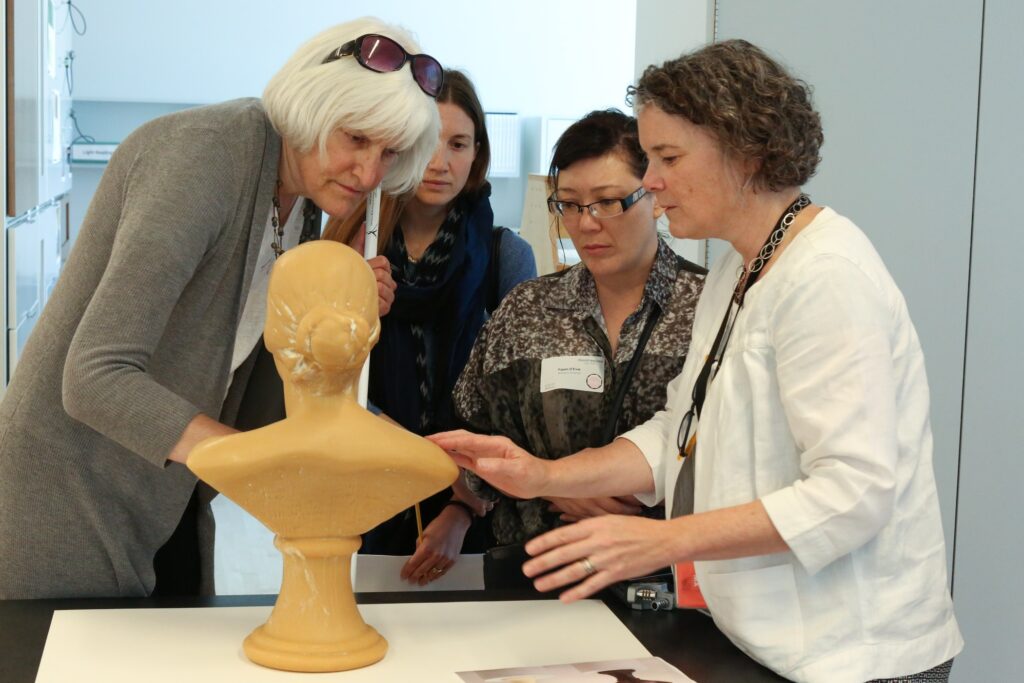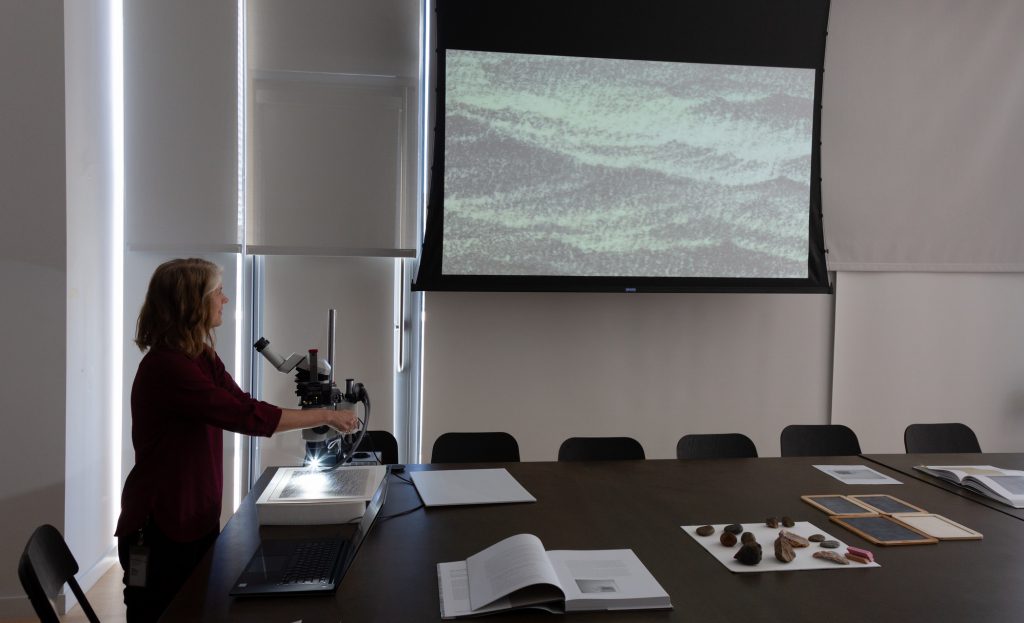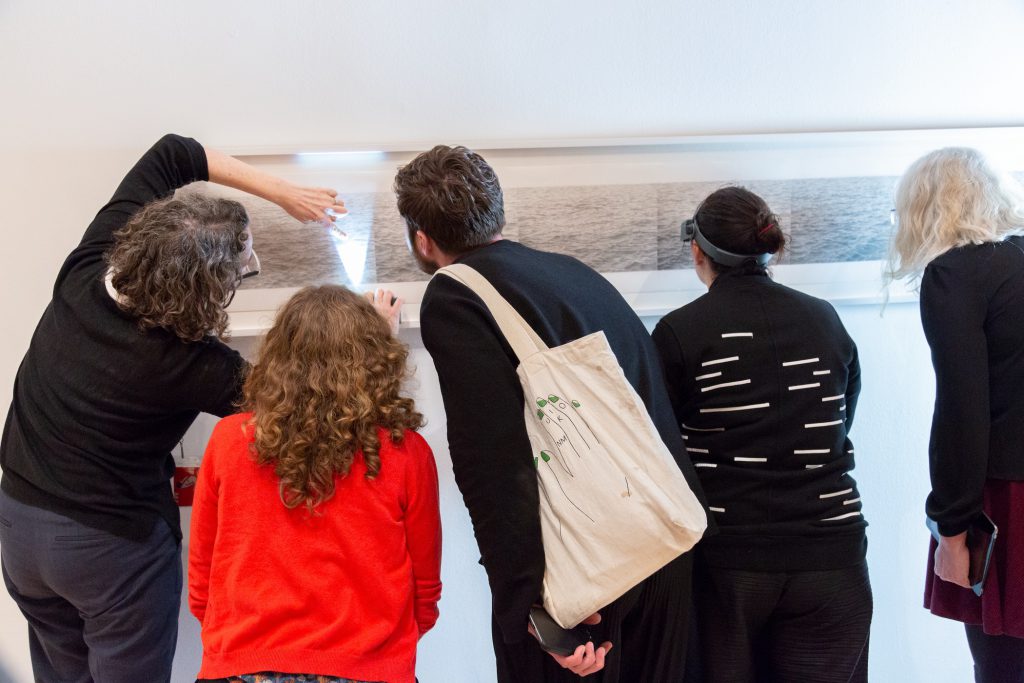A radical shift in conservation practice at SFMOMA has created structural space for an alliance between blindness and conservation, animating sensory research around artworks and artists represented within the collection. The latest chapter in this collaborative inquiry focused on Vija Celmins’s exhibition To Fix the Image in Memory.
“In the past, we tended to be the naysayers,” recalls paintings conservator Paula De Cristofaro, reflecting on the evolution in conservation practice that she has witnessed over nearly three decades at SFMOMA. Audiences, with their oily fingers and microbe-laden breath, were previously thought to be antithetical to protecting the pristine state of fragile artworks, and were unwelcome in the conservation workroom. In the 1990s, the pronounced degradation of key works, particularly latex sculptures by Eva Hesse, and failed interventions by conservators to stem the pace of material degeneration, fractured the defensive ethic of conservation rooted in the authentic original. In the heated debate that ensued, questions were raised about how the practices of artists working with ephemeral materials might be remembered and positioned by future art historians. As SFMOMA pivoted toward the acquisition of contemporary works by living artists, often selecting works that troubled the notion of a stable form, conservators were charged with caretaking the inevitable aging of works, and rethinking what it might mean to collect a practice rather than an object.
Challenged to expand their skill sets beyond the material to the immaterial, the conservation team turned to artist interviews to clarify what might constitute “the artwork” and to deepen their understanding of ephemeral materials and idiosyncratic methods. Models, samples, mock-ups, tests, and molds, donated by artists or resulting from experiments by the conservation team, were amassed in the museum’s Artist Material Archive. This goldmine of secondary material did not carry the same value propositions as the accessioned artworks, so could withstand more intensive study and close handling. The conservators seized on this as an opportunity to introduce fissures in the hermetic seal of their workroom, shepherding the use of the Artist Material Archive as a research or pedagogical resource.
De Cristofaro now embraces the expansion of her role to include school tours: “I love to give a fifth grader a mock-up of a colourful Ad Reinhardt painting and say, ‘I want you to touch this. I want you to see what happens when your greasy fingers go over the pristine surface of the painting.’” There is a crucial point interlaced within this quip, one pivotal to the politics of blindness. Within the museum, the conservation team holds the specialist knowledge necessary to gauge the codes of conduct appropriate for each artwork at a granular scale, and how these codes may shift over time. They are best placed to discriminate between forms of interaction that risk compromising the integrity of a work, versus those likely to have minimal consequence. Rather than insisting on an absolute ban on touching, conservators are able to introduce nuance into permissible encounters. With the magnitude of visitor numbers that SFMOMA experiences, defining the intensity of the interaction is key. A glancing touch by a few could be catastrophic when multiplied by thousands. Yet, if small groups can work with conservators in ways that establish and deepen mutual trust, there is scope for low-intensity handling, close contact, and sensorial intimacy with works in the collection and the Artist Material Archive. Herein lies the opportunity for an alliance between blindness and conservation to innovate sensorial research.
Blind audiences are marginalized in art museums to an extraordinary degree. In an essay on the museum as the place of those who have no (p)art, artist Jennifer Justice ruminates on her complicated entanglement with museums of art as a blind woman: “I really love museums, or I’ve loved a few, even if they didn’t always love me back.”[1] Justice has felt “the sharp sting of knowing [such] spaces were not designed with people like me in mind,” more often than she wishes to expend time and labor tallying. Rejecting the worn social contract that relegates blind audiences as secondary, Justice chooses to turn to Jacques Rancière’s ambition for the public museum as a device for shifting who might be enfolded in a recognized social “we.” I align with Justice’s urging that artists with disability claim responsibility for writing new scripts that overturn expectations of how bodies move through and experience museums of art.
For the past two years, I have been collaborating with SFMOMA’s Artist Initiative on an incremental research project, “Relocating Echoes,” exploring ways that blindness can innovate methods for sensing, archiving, and recalling ephemeral encounters with artworks. A close ally in this work has been Georgina Kleege, a leading scholar on blindness and art, and my co-conspirator in assorted artistic experiments, from cultivating a role for blind docents, to transfiguring audio description as a literary medium. Throughout our research, SFMOMA’s head of conservation, Michelle Barger, has been on hand to establish rules of engagement for our experiments in sensory encounter with artworks and with artist materials. Under her tutelage, we have run our fingertips over a deaccessioned soap bust by Janine Antoni, feeling contours where the artist lathered the soap away, tenderly bathing this cast of herself.

On another occasion, Barger wrapped the tip of Kleege’s mobility cane in wadding, then permitted Richard Serra’s large-scale sculpture Sequence (2006) to be shorelined, a technique of cane navigation that follows an edge through light contact. By squeezing a piezo transducer pickup under one of Sequence’s plates, we could listen to — and record — Kleege’s orientation and disorientation vibrating through the monumental form.
Serra’s Sequence suited performative exploration through blindness. The explanatory text installed on a nearby wall at SFMOMA even included a quote by the artist describing his interest in a more-than-ocular experience: “I found very important the idea of the body passing through space, and the body’s movement not being predicated totally on image or sight or optical awareness, but on physical awareness in relation to space, place, time, movement.” When Kleege and I were invited by the Artist Initiative to conceive of a sensorial encounter in connection with Vija Celmins’s exhibition To Fix the Image in Memory, the prospect was more daunting. Kleege admitted that Celmins’s work was something she would ordinarily avoid: “Scanning galleries of mostly monochrome, mostly small-scale images . . . all I can make out are scores of seemingly empty frames.”[2] Celmins’s frames did not appear as blank to me, but as smears of gray, as tonal variations blurred through myopia and refracting through cataracts. I leaned in close to one drawing, protected by glass frontage. Sharp details pulled into focus. Flecks of graphite accreted to form the contours of a billowing cloud. A guard called out and insisted I stand back if I wished to remain.
It is unsurprising that no tailored audio description had been produced for blind audiences. The standard audio description protocols would have struggled with Celmins’s dedication to repetitive themes and serial imagery. However, a rich audio guide had been produced that suggested a pathway through the exhibition (presuming an ocular-normative visitor), with anecdotes from the artist and curatorial commentary. Under the watchful eye of the guard, I settled at an acceptable distance to listen to Celmins’s reflections, which were somehow meandering yet incisive:
From far away, they’re only proportion, you know, you see black proportion. And when you get close . . . you begin to see the image, and hopefully you have a kind of a surprise. . . . I like the idea that actually the space in front of you is impenetrable, but it refers to a space that . . . is endless. . . .
These are . . . places that really don’t exist except in your mind because we have only seen them in photographs. . . . What I did here is, these drawings are all additions, and the white is all the paper. I don’t really think of them as stars. I mean, they’re stars, but not stars. I think of them like undetonated . . . little bombs . . . that I have to go around and articulate so that they sit correctly on the page.
Celmins closes the latter anecdote with a self-effacing question to her interviewer: “This is too much talking, isn’t it?” Thinking through blindness, my response must be a resolute “No!” Confronted by an exhibition of such extreme inaccessibility — no handling allowed within the gallery, no audio description, no audiobook or screenreader-friendly version of the exhibition monograph — conversation offers a conduit to encountering works. Celmins speaks of her method of transposing photographic imagery as “redescribing” rather than copying or reproducing. In an essay in the exhibition catalogue, Frances Jacobus-Parker writes of redescription as “a layered process of notation and repetition . . . that produces dialogues across images, between different modes of production and perception.”[3] It struck me that, oriented through blindness, the exhibition could be considered like Celmins’s undetonated bombs: an absence that could be articulated through circumnavigation. Through rigorous redescription of the periphery, blindness could introduce new densities of conversation, accreting discursive mass around the artist’s practice.
On a rainy Wednesday, we gathered in the conservation studio for a workshop I had scored through redescription, extreme myopic reading, and listening. A cadre of conservators hovered as we took our seats around a large workroom table. Between us, there was a quorum of perspectives that grounded the conversation in blindness. Three of us were legally blind, and three more had low, degenerative, or fluctuating vision, myself included. The Artist Initiative had invited a few colleagues from various departments across the museum. We had also invited several guests, mostly artists known for sensorial curiosity, or at least an openness to conversation beyond epistemic or perceptual familiarity. We began with proximate readings of Celmins’s works, listening to excerpts read from the exhibition catalogue. We heard Jacobus-Parker depicting Celmins’s process as “an embodied journey of sensory and intellectual ingestion over time,” referencing a quote from Celmins: “I thought I was like a scribe. I was going over the surface like a little ant, redescribing through my body, my intelligence, my eyes, my hands. Remaking the image, leaving my traces, bringing it into another space and context.”[4] Architect Chris Downey honed in on the ant’s footfall as similar to fingertips reading a tactile drawing, both acts implying intimacy and immersion. Justice spoke of her attraction to the scribe as performing intellectual labor, which led me to recall a resonant quote from Hélène Cixous: “hypersensitive to details, my approach as a scrutinising ant, my sensitivity to the least sign . . . my myopia is like my writing: these are fertile congenital disabilities.”[5]
Paper conservator Amanda Hunter Johnson had deinstalled one of the drawings from the exhibition, Untitled (Ocean) (1977), and had removed the paper work from its protective frame. She slid the drawing under a stereo microscope connected to a camera and projector. A movie-scaled image of the drawing was cast on a screen before us.

Even some of us with low or residual vision could detect the thick masses of graphite that sculpted the waves, the absences that articulated foamy peaks. Kleege led a polyphonic description exercise. “Where does your eye go first?” she asked. “If you could touch this, what would it feel like?” Peter Samis described a dark-haired poodle’s coat or iron filings. Robert Kett suggested stratigraphic layering of rock. Justice was reminded of the gritty dampness of hard-pressed wet sand. Ala Ebtekar spoke of static electricity. We examined the edges of the drawing, investigating whether the acrylic ground was obscuring the texture of the paper. (It was not.) Like scrutinizing ants, we focused our attention on the slightest details, extreme myopic readings that would elude 20/20 vision.
Later, in the gallery, Kleege led a choreographic description exercise for Untitled (Ocean Steps #2) (1973), starting at a distance, then slowly approaching the work. Those with visual perception described a photographic test strip, segmented bamboo, a timeline, a grayscale progression of pages from dark to light. Close up, Kleege asked for volunteers to walk past the work, parallel to the wall, and describe their peripheral impressions. Claire Bradley spoke of the dominance of reflections of the workshop group in the glass. Hillary Goidell discovered a tendency to veer away from parallel, her body leaning into the darker panel, or falling away from the lighter panel. Don Ross read aloud the wall text for the work, which described Celmins’s interest in constructing a perceptual exercise for viewers. “I tried making the experience more complicated . . . by elongating. . . . So you really have to back up and orient yourself to it or . . . walk along it.” Borrowing a conservator’s headloop, Justice peered at the drawing through magnification and remarked on the meticulous precision of each rivulet. In a smaller gallery of drawings of clouds and moonscapes, we experimented with conversational description in pairs and trios. Again, those with no or less residual vision propelled descriptive subtlety through sustained questioning. With a headloop on, and raking torchlight at an angle across the surface of one drawing, I could detect Celmins’s transposition of the fine-grained texture of the original paper stock, where the source imagery of moon craters had been torn from a magazine page.

For our last session, we returned to the workroom, reasserting shared distance from ocular apprehension of the exhibition. We handled bronze casts of rocks, mock-ups the conservators had created to deepen material understanding. We listened closely to shifts in pitch as we drew with graphite pencils of differing hardness, on paper painted with the thin acrylic ground that Celmins applies. We speculated on creation of a sonic archive of recordings of drawings in progress. Ernst Karel had pointed to the incongruence of the postproduction compositions — perhaps synthesized wind chimes and pan flutes — that pierced the sensory scape of the exhibition audio guide, distracting from Celmins’s vocalized ruminations. Taking a cue from sensory ethnography, we discussed privileging audio recordings of the sensorial setting of an interview, like the exhibition galleries or the artist’s studio. Here, a trans-sensory approach could contribute to the descriptive archive of the artist in situ, and the contexts that surround and support an artist’s practice. Such audio recordings offer a way of carrying the vibratory echoes of an intimate encounter to an expanded public audience.
Another method is textual reflection, exemplified by Kleege’s essay on the workshop, “Turning a Blind Eye on Vija Celmins: Describing Redescription.” Kleege writes of the sensual performance of a drawing investigation, scored by Celmins’s materials and processes of incremental accretion. Kleege listens to the “dry whisper” of harder graphite pencils. She senses a light stickiness as a softer pencil pushes graphite across the page: “a faint kiss as the point left the surface.” The impossibility of a 20/20 visual encounter with Celmins’s drawings and paintings opens room for a surrogate experience that foregrounds the embodied choreography of Celmins’s practice: “I am left with vivid impressions in my mind’s hand, and in my literal hands. . .” Her essay offers proof-of-concept that through conversation and sensorial enquiry, outsights can be generated that expand the bodies of knowledge that surround an artist’s practice, beyond normative perceptual habits.
The denigration of blind bodies as subnormal is rampant within historical and contemporary art discourse. In Michael Fried’s Absorption and Theatricality: Painting and Beholder in the Age of Diderot, he exalts the skill of Parisian painters who exploited blindness as a narrative structure to assert the primacy of absorption —the fiction that painted subjects are so absorbed as to be unaware of being gazed upon by an external viewer. Fried’s climactic final chapter is devoted to paintings of blind Belisarius receiving alms, where Fried pronounces that “Belisarius’s blindness, which rendered him unaware of being beheld . . . could be perceived as an exemplary mode of obliviousness.”[6] Of course, from the perspective of lived blindness, such obliviousness is an illusion, one that neglects the array of perceptual experiences encompassed by blindness, and denies complex sensorial ways of knowing beyond the retinal.
Supplanting Fried’s pejorative notion of beholding, the alliance of conservation and blindness exemplifies a form of be-holding that reclaims the etymological root bihalden, a conjoining of bi-, thoroughly, and –halden, to hold, handle, guard, preserve, take care. Thoroughly attentive to the slightest details of artworks and artists’ practices, conservators care for both the material and the immaterial through intimate guardianship. The intricacies of their handling of works, materials, and histories are rarely exposed. By inducting small blind audiences into the nuanced codes of conduct demanded by specific fragilities, conservators have created structural space for blind collaborators to contribute to bodies of knowledge beyond the ocular-normative, and to carry stories of these be-holding events to a broader public audience. The conservation workroom has been reinvented as a place for hybrid artistic-curatorial practice and radical disability justice, inverting the pervasive exclusion of blind audiences to animate sensorial research around artworks and artists of significance.
Fayen d’Evie is an artist based in Muckleford, Dja Dja Wurrung, Australia.
[1] Jennifer Justice, “Rancière’s Dissensus and the Museum as the Place of Those Who Have No Part,” Dissensus, forthcoming (2019).
[2] Georgina Kleege, “Turning a Blind Eye on Vija Celmins: Describing Redescription,” SFMOMA, 2019.
[3] Frances Jacobus-Parker, “Redescribing the Photograph,” in Vija Celmins: To Fix the Image in Memory (New Haven: Yale University Press; San Francisco: San Francisco Museum of Modern Art, 2018), 84.
[4] Ibid.
[5] Hélène Cixous and Mireille Calle-Gruber, Rootprints: Memory and Life Writing (New York: Routledge, 1997), 89.
[6] Michael Fried, Absorption and Theatricality: Painting and Beholder in the Age of Diderot (Berkeley: University of California Press, 1980), 149.